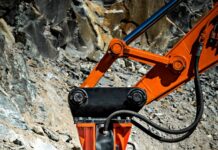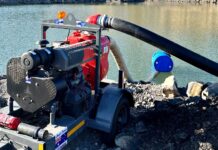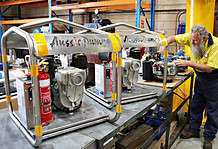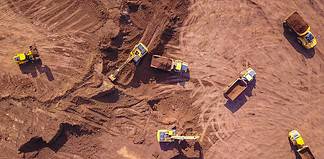An arc flash can be many thousands of degrees and cause injuries from minor burns through to severe lacerations and even blindness. Image: Shutterstock.
AN arc fault can be spontaneous, due to a breakdown of the conductors phase to phase or phase to neutral; ground or inadvertently bridging electrical phases; or contacts with a conductive object.
The result is a sudden release of electrical energy (incident energy) through the air and a massive electrical explosion.
The arc flash is the blinding light and intense heat that can result.
In the arc it could be many thousands of degrees in temperature more than four times hotter than the surface of the sun, and in the plasma cloud (ionised gas) that erupts, it could reach around 5000OC.
The arc blast is the pressure wave that contains toxic hot gases, with smoke, molten metal and flying debris ejected in the blast.
Injuries can include minor to third degree burns, blindness, hearing loss, severe lacerations, cardiac arrest and in the worst case be potentially fatal.
Incident energy and personal injury is increased by any or the combination of any of the following factors:
-
-
- higher fault currents
- longer protection clearing times
- shorter distances from the arc fault
-
In the general course of work, electricians are required to perform a variety of tasks in a single day.
If the task involves working near energised parts, a risk assessment should be completed and appropriate control measures implemented before starting the task.
Where possible, evaluating and eliminating the risk entirely is always the best course of action.
Control measures taken could be, for example, shutting down an entire switchboard board to avoid working near energised parts.
Incidents of arc faults do continue to happen and are a real risk to workers performing live testing, fault finding or inadvertently working near exposed live parts.
These may be caused by inexperience, the site or equipment to be worked on could be unfamiliar, boards can be incorrectly marked, fatigue, the entry of unauthorised persons, time pressures or any number of unforeseeable hazards.
Electrical factors can also contribute, such as incorrect isolation of circuits, faulty test equipment, undischarged capacitators or unidentified energy sources.
One product worth considering is the EFO PU240 battery-powered proving unit that outputs a simulated 240V AC waveform to provide a safe and reliable method of checking the correct functioning of multi-meters; and two-pole voltage indicators before and after use as advised in the Safe Working Practice guidelines for electricians.
When “proving for dead” it is an essential part of the workers’ procedure that test equipment is operating correctly.
Mechanical factors may be present, such as the unplanned movement of equipment, falling objects or trip hazards.
Personal protective equipment (PPE) is the lowest in terms of importance in the hierarchy of arc flash control measures (i.e. elimination, substitution, isolation, engineering, administration, PPE) but, as the last line of defence, it is still critically important.
Choosing the correct PPE and level of protection is essential.
The following guidelines and standards listed below can assist with making that determination.
Specialists may also need to be called in to correctly evaluate the potential incident energy levels, risks and to advise on control measures.
PPE Categories
To understand what cal/cm2 represents in terms of heat, the common explanation is 1 cal/cm2 = holding one match under your finger for one second; similarly, 8 cal/cm2 = holding eight matches under your finger for one second. Reported injuries resulting from arc flash often involve burns to the hands, face and upper body so following are some PPE options covering these areas.
- AS/NZS 4836:2011 Safe working on or near low-voltage electrical installations and equipment
Section 9, Table 9.1 and Table 9.2 provide guidelines of the selection of personal protective equipment in relation to the type of work performed and the potential current present at the work area.
- Electrical Arc Flash Hazard Management Guideline March 2019
Australia Energy Council (AEC)
ENA NENS 09-2014
National Guideline for the Selection, Use and Maintenance of Personal Protection Equipment for Electrical Arc Hazards
Energy Networks Australia
IEEE 1584 & NFPA 70E
Standard For Electrical Safety in The Workplace is the American Standard and has been commonly used and referred to as a resource for assisting in selecting appropriate PPE for electrical workers within facilities with large diverse electrical systems, determining approach boundaries and calculating the incident energy (potential calorie rating)
Protection for hands
Leather gloves should be worn over insulated gloves that offer fire resistance and protect the rubber gloves.
There are now flame-resistant materials for gloves: the Powerflex is an example of a glove which is extremely comfortable and allows great dexterity of the fingers, offers a high cut protection, secure grip and is rated HRC2 12.0 cal/cm2.
The materials used in the glove are inherently flame-resistant even after washing.
Protection for arms, torso and legs
ENA NENS 09-2014 concludes that plain cotton is not suitable for general clothing for electrical workers as the cotton fabric can ignite in the event of an arc fault.
Workers should wear a minimum of 4 cal/cm2 or higher arc rated fire-resistant clothing long sleeve shirts and trousers to provide a level of PPE Category 1.
Arc flash coveralls can be worn to increase the protection to PPE2 or greater than 8cal/cm2.
The next consideration would be full arc flash Kits for low energy risks. The EFO Arc Flash Kit HRC2, which contains a face shield, balaclava, coverall and glove kit and hi-vis carry bag, provides a convenient solution to PPE2 level protection.
Higher energy risks require switching suits, which can be rated up to 40 cal/cm2. The EFO Arc Flash Kit HRC4 can be supplied in various configurations of bib and braces and short jacket or a long jacket and leggings, full hood or lift front face shield to PPE4 level protection.
Protection for the face
Face shields can consist of a fully enclosed hood or the increasingly popular helmet with a lift front.
Some manufacturers have improved the colour recognition and general visibility to allow workers to correctly distinguish colours through the arc face shield.
Anti-fog and anti-scratch coatings have also been developed.
EFO has just released a range of LV and HV wall-mounted rescue and operators kits.
For permanent installations in manufacturing industries, mines and utilities that have repeat tasks performed, the water and dust resistant wall-mounted safety cabinet allows the correct operators PPE and the observers rescue equipment to be readily available at all times.
Often the task required, such as switching, can be performed quite quickly and the convenience of having the PPE on hand to utilise makes compliance easier.
Standard configurations contain a rescue kit grab bag and operator’s face shield and insulating mat.
Additional items can be added, such as coveralls, glove kits, switch board drapes and a balaclava.
For further information please contact Electrical Factory Outlet on Ph 07 32094333
www.electricalfactory.com.au















































